
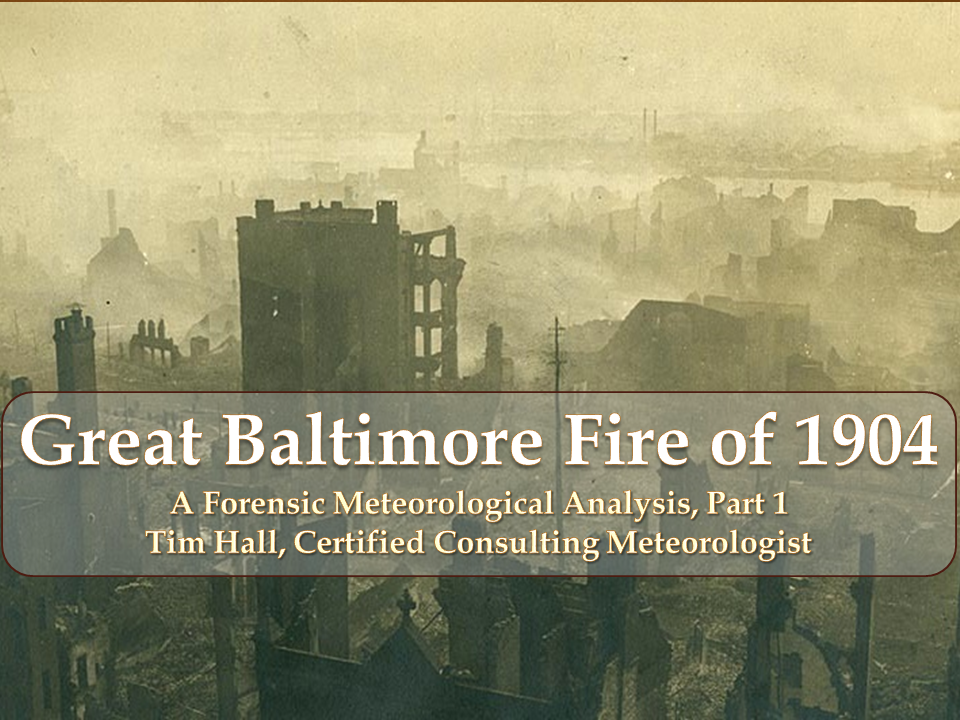
On February 7-8, 1904, the heart of Baltimore was scorched by a wind-driven conflagration of horrific magnitude. It remains the third largest urban mass fire in U.S. History topped only by the San Francisco Fire and Earthquake of 1906 and Great Chicago Fire of 1871. This is the story of the Great Baltimore Fire of 1904 as told through the retrospective eyes of a forensic meteorologist.
A lookback published in Baltimore's Sun Magazine in February 1948 captured the moments leading up to the fateful, silent alarm at the J.E. Hurst & Company Building - in the proverbial calm before the storm preceding 32 hours of hell for Baltimore's business district:
"As church bells pealed on that cloudy, blustery Sunday morning of Feb. 7, 1904, Baltimore women were on the way to services held in their elegant broad-brimmed hats, loosely perched atop pompadours. The southwest wind tugged at their full sweeping skirts, permitting glimpses of high-button shoes and cotton stockings.
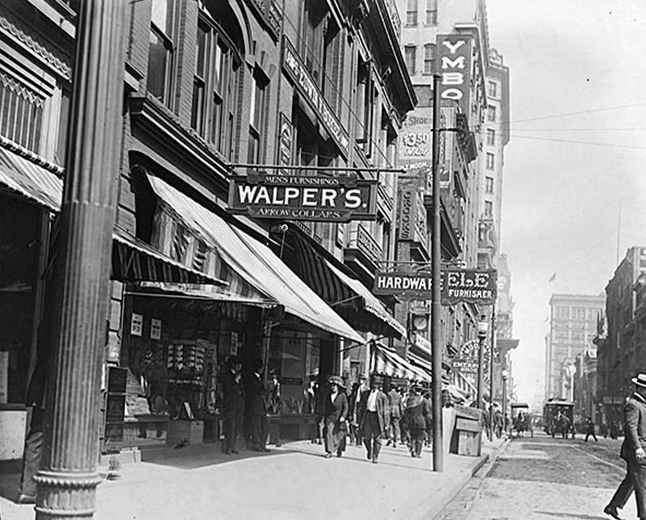
Mustachioed men in high winged collars - some of freshly scrubbed celluloid - clutched their derbies, too, as they squired the women across cobble-stoned streets, keeping a wary eye on the horses and carriages.
The brisk wind on an otherwise quiet Sunday morning in Baltimore sang in the maze of telephone and telegraph wires strung on wooden poles above the streets, and it had been humming and moaning most of the night before at the windows and doors of houses. But no one had detected any omen of disaster in its eerie cry.
There had been the usual leisurely Sunday breakfasts of kidney stew and waffles - and the Sunday papers. War between Russia and Japan seemed certain.
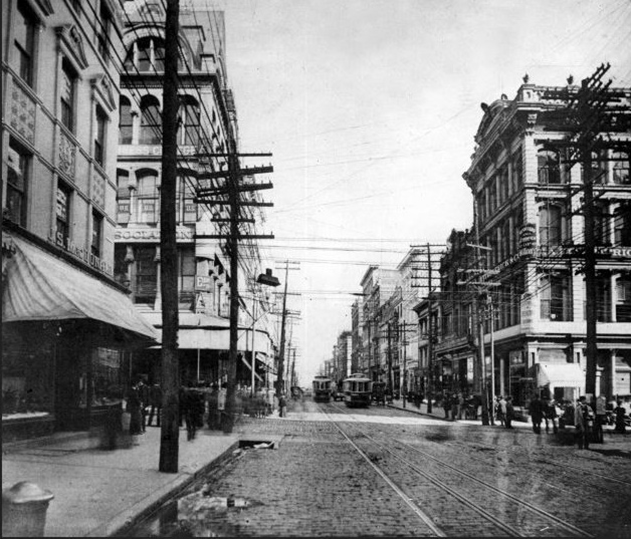
But the news faded into the background at church amid the sermons and hymns and the swish of petticoats as congregations knelt, stood or sat in accord with ritual. A little before 11 o'clock, citizens in downtown attending church and other business heard the distant clang of fire-engine bells... a few minutes later a terrific explosion jarred windows, and then there was a scuffle of people running into the streets mingled with the gallop of fire horses. Bells and sirens sounded in all directions.
And when, as services ended and people poured into the streets, they saw great flames billowing in a pall of black smoke over Hopkins place."
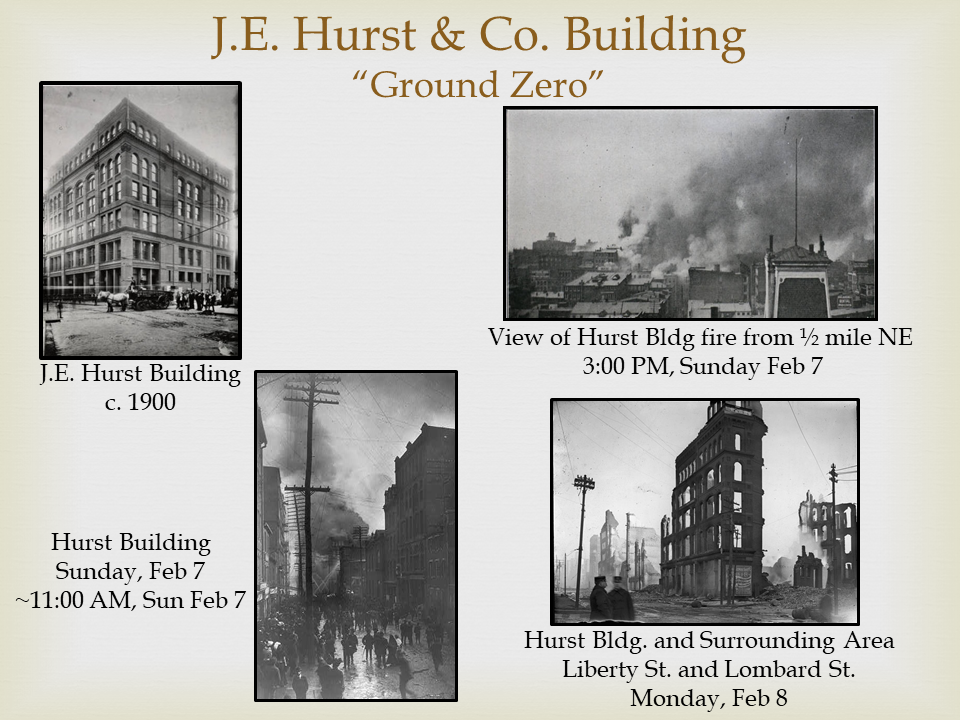
Propelled by the wind, the fire that ignited at Hopkins Place in the Hurst Building grew into a dangerous conflagration that burned steadily in full volume for 32 hours - not declared under control until 5:00 p.m., Monday Feb. 8. Note that all times through this article are Eastern Standard Time (EST). The photo on the upper left of Fig. 3 shows the Hurst Building before the fire, circa 1900. The image on the lower left was taken about 15 minutes after the initial alarm. On the upper right we catch a 3:00 p.m. view of the spreading and intensifying fire in the vicinity of the Hurst Building from an elevated vantage point about a half mile to the east. Note from this perspective the clear slant to the right reflecting the effect of the strong southwesterly wind carrying smoke, ash and hot embers to the northeast (moving left to right in the photo). The photo on the lower right was taken in the aftermath on Monday, Feb. 8 even while the fire still raged a mile to the east.
On Monday morning, Feb. 8, the fire dominated the headlines around the nation (Fig. 4). In the early storyline the event was already being pegged as one of the most horrific conflagrations in American History. By 5:00 p.m., 1,526 buildings housing 2,500 businesses were destroyed (Fig. 5) putting 35,000 people out of work and causing a reported $150 million in damage, which equates to over $4 Billion in 2018 U.S. dollars. Incredibly, there were only 5 fatalities related to the fire.
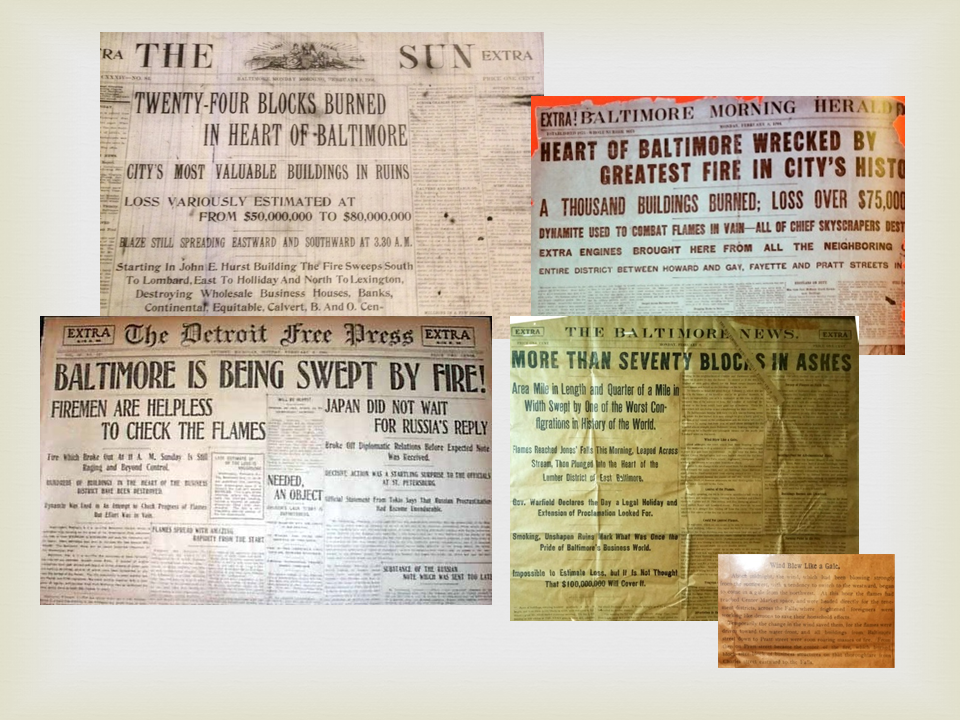
About five years ago, I visited the Fire Museum of Maryland in Lutherville outside of Baltimore where there is an extensive, interactive exhibit chronicling this event. What fascinated me about the story were countless references to the wind conditions that frustrated efforts to get this blaze under control - and the absence of an authoritative meteorological analysis. So, I decided to conduct a forensic meteorological investigation.
As I sifted through the historical data and on-the-scene reports, a rich weather story emerged involving a range of synoptic to microscale meteorological phenomena featuring dramatically shifting conditions over the course of the 32-hour event. Along the way I discovered lesser known anecdotes that will interest weather enthusiasts.
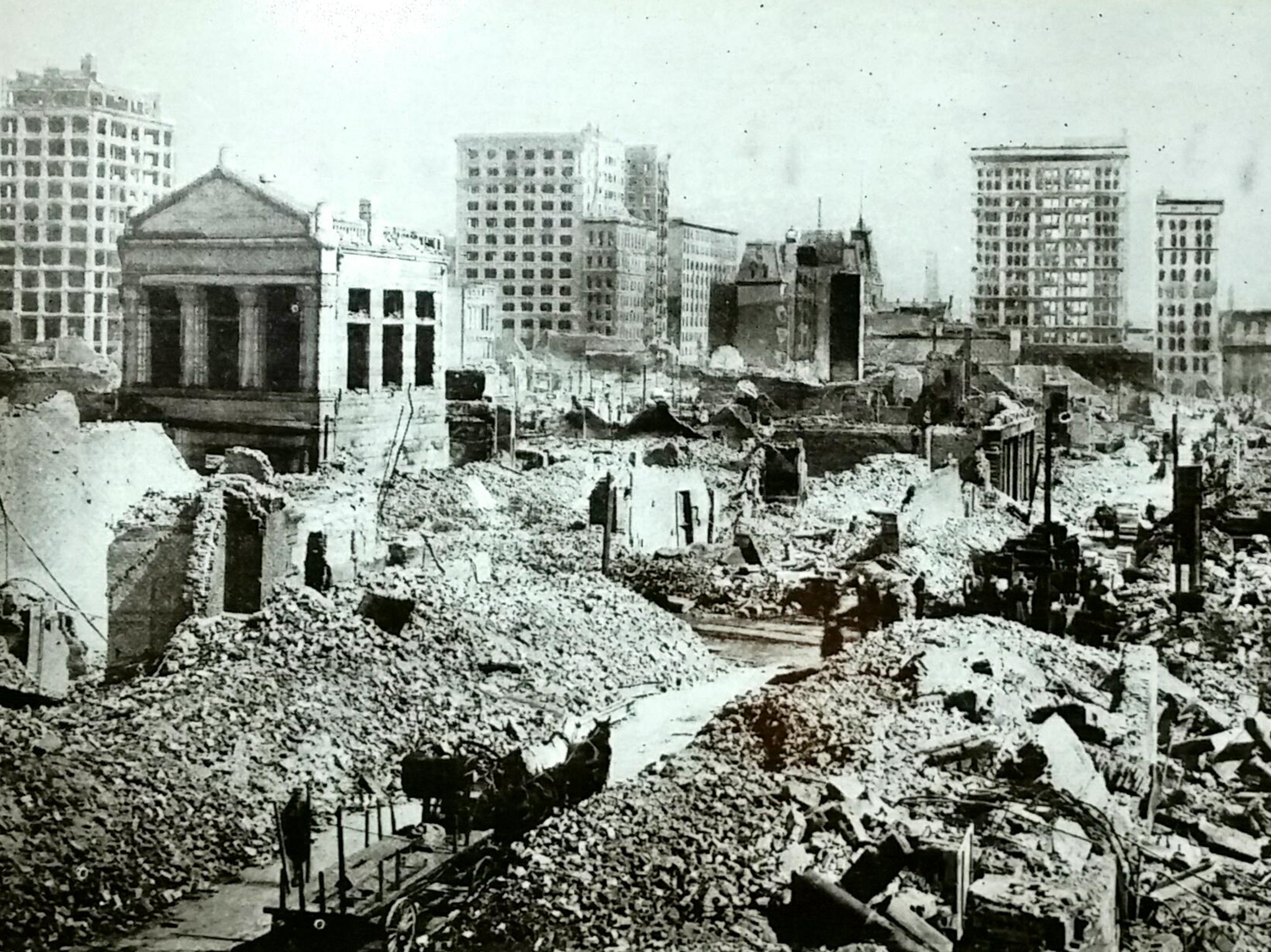
[1] Sun Magazine (Title of article not available), Henry F., Published February 1, 1948.
[2] U.S. Daily Weather Maps available at: https://library.noaa.gov/Collections/Digital-Collections/US-Daily-Weather-Maps
[3] Anemometry (Circular D, Instrument Room), C. F. Marvin, Published 1893, U.S. Department of Agriculture, Weather Bureau, 40 pp. https://github.com/WeatherSleuth/1904-Baltimore-Fire/blob/master/Anemometry_Marvin_1893.pdf
[4] Wind Speeds Over Short Periods of Time, C.S. Durst, Meteorol. Mag., 89: 181-186, Published 1960.
[5] Report of the Chief Engineer, George W. Horton, Published 1904.
[6] The Baltimore Sun Almanac, Story of the Baltimore Fire, Published 1905.
[7] The Great Baltimore Fire, Peter B. Petersen, Published 2004 by the Maryland Historical Society, Baltimore (Md.), p. 192. ISBN 978-0938420903
[8] Wind Effects on Fires, W. M. Pitts, Prog. Energy Combust. Sci., Vol 17: 83-134, Published 1991.
[9] Firebrands and spotting in large-scale fires, Eunmo Koo and co-authors, International Journal of Wildland Fire, 19, 818-843, Published by CSIRO Publishing.
[10] Spot fire distance from burning trees-a predictive model, F. A. Albini, General Technical Rep. INT-56, Published 1979 by U.S. Forest Service
[11] The Great Conflagration: Chicago - its Past, Present and Future, J.W. Sheahan and G.P. Upton. Published 1872 by Union Publishing, Philadelphia, PA.
[12] The Great London Fire 1666, W.G. Bell. Published 1920 by John Lane Company, London.
[13] The Fireman's Record, J. Albert Cassedy, Vol II, Published 1911 by The Association, 336 pp. Available from UMBC Digital Collection: http://contentdm.ad.umbc.edu/cdm/compoundobject/collection/firemensrec/id/340
[14] Baltimore Weather Bureau Office Daily Journal from 7-8 February, 1904. Available from National Centers for Environmental Information (NCEI).
[15] History of the J.P. Freiz & Sons Co, A Thesis Prepared for the Phi Mu Honorary Engineering Fraternity, George R. Phipps, 1929, 15 pp. Available at https://github.com/WeatherSleuth/1904-Baltimore-Fire/blob/master/history_of_jp_friez_co_1929.pdf
[16] Mass Fires and Fire Behavior, C. M. Countryman, Rep. PSW-19, Published 1964 by the U.S. Forest Service
[17] Fire weather conditions and fire-atmosphere interactions observed during low intensity prescribed fires - RxCADRE 2012, C.B. Clements and co-authors, International Journal of Wildfire, 25, 90-101, Published 2016 by CSIRO Publishing.
[19] Billion-Dollar Weather and Climate Disasters, National Centers for Environmental Information as of 21 Dec 2018. Available at: https://www.ncdc.noaa.gov/billions/events/US/1980-2018
[20] Souvenir of The Baltimore Fire , February 7th, 8th, and 9th, 1904 As Seen Through a Camera, Hement, J. , Published 1904 by the A.B. Benesh Company available through Library of Congress, Digitized Internet Archive: https://archive.org/details/souvenirofbaltim00heme/page/n1
[21] Illustrated Catalogue of Meteorological Instruments and Apparatus (A Handbook of Meteorology in Respect to Standard Meteorological Instruments), Julien P. Friez, Published 1893 , 77 pp. (Smithsonian Library) https://github.com/WeatherSleuth/1904-Baltimore-Fire/blob/master/Friez_catalog_1893.pdf
Note: All images are in the public domain (pre-1923) unless otherwise noted.
Front Cover. Looking southeast from Continental Trust Build; Maryland Historical Society, The Great Baltimore Fire Photograph Collection, PP179.174: http://mdhsphotographs.tumblr.com/post/75914714665/looking-southeast-from-continental-trust-building
Figure 1. Baltimore and Chase St., c. 1900; Maryland Historical Society
Figure 2. Baltimore St., c. 1900 (http://darkroom.baltimoresun.com/2014/02/great-baltimore-fire-of-1904-110-years-later/#29)
Figure 3.
Upper Left: Hurst Bldg c. 1900 (http://collections.digitalmaryland.org/cdm/singleitem/collection/mdbf/id/183/rec/172)
Upper Right: 3 PM view from 1 mile east (Library of Congress) https://www.loc.gov/item/2012646412/
Lower Left: Hurst Bldg 15 minutes after alarm (Library of Congress) https://www.loc.gov/item/2007677299/
Lower Right: Hurst Bldg. and vicinity (Library of Congress) https://www.loc.gov/item/2016844557/
Figure 4.
Fire Museum of Baltimore for Baltimore Papers.
Detroit Free Press front page: http://www.rarenewspapers.com/view/219605?imagelist=1
Figure 5. Source unknown from archives of Fire Museum of Baltimore.